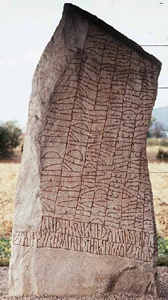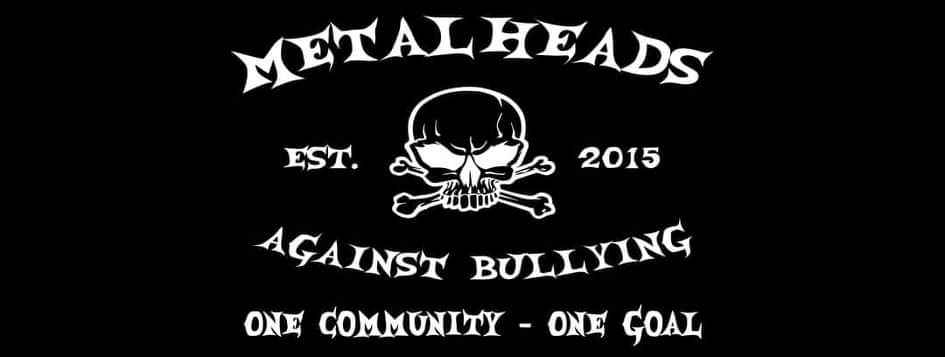You might ask why some call the short-twig runes ‘Rök Runes‘. Here’s my attempt at an explanation, and a little info about the Rök stone. Short-twig runes are a variation of the Younger Futhark and first appear around the 800’s. The Younger Futhark has 16 runes, which replaced the 24 of the Elder Futhark. Several of the runes, therefore, represent more than one sound. The fact that it got reduces, is a bit of a paradox. Since the language had become more complex, not less. As the Elder Futhark, the Younger Futhark is divided into three ætts. Here seen divided by colons:

The last rune is described both as R and y because it was used as a y after they stopped using the palatal R.
The reason why they’re sometimes called Rök Runes, in addition to short-twig runes, is that they appear on the Rök stone, which has the longest rune inscription in the world. It has about 760 runes, and it was inscribed during the first half of the 9th century. The stone is about 380 cm/12.5 ft high, of which about 125 cm/4 ft are below ground. It’s about 138 cm/4.5 ft wide, and between 19 cm/7.5″ and 43 cm/17″ thick. It’s a solid block of light, finely grained granite, and was probably sourced locally. No one knows where it was placed originally. Some think it may have been placed in what was the village centre, and been the source of the village name (Rök).
The name of the stone may have one of several very different meanings. The old word ‘raukr’ in Old Swedish means something like ‘pile’ or ‘object with an apex’. The word ‘rökr’ or ‘rökkr’ in Old Icelandic means twilight (see Ragnarökkr). The word ‘rök’ in Old Icelandic means ‘reason, ground, origin’. In Iceland today, the word ‘rök’ stands for either ‘reasoning, arguments’ or ‘fog, mist, humidity’ and being drunk. So it may be connected to fog or you could take my opinion, which is explanation/reason. All sides of the stone are covered by runes, including the top. Most of the runes are short-twig runes. But there are three rows using the Elder Futhark.
These are thought to refer to Theoderic the Great. The rows are written in the meter fornyrdislag and may have been written like this to confuse the reader. There are also a couple of rows which are written as shift cyphers, and a couple of cypher runes. Punctuation marks are only used after larger portions of the text, not between words. There are no double runes (like the nn in minni), not even when it was at the end of one word and the beginning of another. With the exception of row 19. The stone was found in the wall of a shed belonging to the church.
The church was built in the 1100’s and the shed was used as a warehouse for the ‘tithe’. The runestone was placed inside the wall with the front facing out. In the early 1600’s it was discovered by the of the National Heritage Board, Johannes Bureus. He made a sketch of it and published it in 1624 in his ‘Monumenta Sveo-Gothica hactenus exsculpta’. During the 1670’s, the researcher and secretary of the Antiquities Agency, Johan Hadorph was there and depicted it on a woodcut. This was published in 1750 in the runology book ‘Bautil’ which was written by Johan Göransson.
In the 1760’s, Carl Fredric Broocman describes it as incomprehensible and illegible. When they tore down the old church and the shed in 1843, they diskovered that the stone had runes on all sides. The dean Hedmark sketched the earlier unknown sides before the stone was placed in the wall of the church porch. In 1862, the stone was removed from the wall, after a request from the Science Academy, and erected by the west cemetery wall. In 1933, it was moved to its current location, outside the church grounds and under a roof. It’s original position was probably straighter than it’s current. If you place the vertical rows perfectly vertical, the horizontal rows are also straighter.
On the back of it, there’s some damage which probably came when they removed it from the tithe shed. There’s also some damage on the left side, but judging by the wear this was made long before the church was built. Unfortunately, some of the text is lost. There are many interpretations of the stone, and the reasons why they differ are numerous, among them I could mention that some runes symbolize more than one sound and that the order and direction of reading may differ. Here’s the interpretation that’s posted on the sign by the stone:
| Rad | Modern Swedish | Norse |
|---|---|---|
| 1 | Till minne av Vämod står dessa runor | aft uamuþ stonta runaR þaR |
| 2 | Men Varin skrev dem, fadern, till minne av den döde sonen | n uarin faþi faþiR aft faikion sunu |
| 3 | Jag säger de unga det, vilka de två stridsbytena var | sakum ukmini þat huariaR ualraubaR uaRin tuaR |
| 4 | som tolv gånger blev tagna som krigsbyte | þaR suaþ tualf sinum uaRin numnaR t ualraubu |
| 5 | båda på en gång från man efter man. Det säger jag som det and- | baþaR somon o umisum monum þat sakum ona |
| 6 | -ra vem som för nio släktled sedan miste livet | rt huaR fur niu altum on urþi fiaru |
| 7 | hos reidgoterna och han dog | miR hraiþkutum auk tu |
| 8 | hos dem till följd av sin skuld | miR on ub sakaR |
| 9 | Då rådde Tjodrik den dristige, sjökrigarnas | raiþ þiaurikR hin þurmuþi stiliR |
| 10 | hövding över Reidhavets kust. Nu sitter han rustad på | flutna strontu hraiþmaraR sitiR nu karuR o |
| 11 | sin gotiska häst, med sköld över axln, den främste av Märingar | kuta sinum skialti ub fatlaþR skati marika |
| 12 | Det säger jag som det tolfte var Gunns häst | þat sakum tualfta huar histR si ku |
| 13 | ser föda på slagfältet, där tjugo konungar | naR itu uituoki on kunukaR tuaiR tikiR sua |
| 14 | ligger. Det säger jag såsom det trettonde, vilka | þ o likia þat sakum þritaunta huariR t |
| 15 | tjugo konungar satt på Själland under fyra | uaiR tikiR kunukaR satin t siulunti fia |
| 16 | vintrar, med fyra namn, födda | kura uintur at fiakurum nabnum burn |
| 17 | åt fyra bröder. Fem med namnet Valke, Rådulfs sö- | iR fiakurum bruþrum ualkaR fim raþulfs su |
| 18 | ner, fem Reidulf, Rugulfs söner, fem Haisl, Hord- | niR hraiþulfaR fim rukulfs suniR hoislaR fim haruþ |
| 19 | -s söner, fem Gunnmund, Björns söner. | s suniR kunmuntaR fim birnaR suniR |
| 20 | Nu för de unga säger fullständigt envar (?)… eftersporde (?). | nuk m— (m)– alu –(k)(i) ainhuaR -þ… …þ … ftiR fra |
| 21 | Jag säger de unga det, vem av Ingvalds- | sagwm mogmeni (þ)ad hOaR igOld |
| 22 | -ättlingarna som blev gäldad genom en hustrus offer | iga OaRi gOldin d gOonaR hOsli |
| 23 | Jag säger de unga, åt vilken kämpe en ättling | sakum ukmini uaim si burin ni |
| 24 | är född. Vilen är det. Han kunde krossa | þR troki uilin is þat knuo knat |
| 25 | en jätte. Vilen är det. Nit. | i iatun uilin is þat |
| 26 | Jag säger de unga: Tor | sakum ukmini þur |
| 27 | Sibbe viets väktare | sibi uia uari |
| 28 | avlade nittioårig (en son) | ul niruþR |
As always. If you want a reading, you’ll find prices and info here: https://lindaursin.net/library/
And my shop is at https://lindaursin.net/magical-creations
The reason why they’re sometimes called Rök Runes, in addition to short-twig runes, is that they appear on the Rök stone, which has the longest rune inscription in the world. It has about 760 runes, and it was inscribed during the first half of the 9th century. The stone is about 380 cm/12.5 ft high, of which about 125 cm/4 ft are below ground. It’s about 138 cm/4.5 ft wide, and between 19 cm/7.5″ and 43 cm/17″ thick.
It’s a solid block of light, finely grained granite, and was probably sourced locally. No one knows where it was placed originally. Some think it may have been placed in what was the village center, and been the source of the village name (Rök). The name of the stone may have one of several very different meanings.
The old word ‘raukr’ in Old Swedish means something like ‘pile’ or ‘object with an apex’. The word ‘rökr’ or ‘rökkr’ in Old Icelandic means twilight (see Ragnarökkr). The word ‘rök’ in Old Icelandic means ‘reason, ground, origin’. In Iceland today, the word ‘rök’ stands for either ‘reasoning, arguments’ or ‘fog, mist, humidity’ and being drunk. So it may connected to fog or you could take my opinion, which is explanation/reason.
All sides of the stone are covered by runes, including the top. Most of the runes are short-twig runes. But there are three rows using the Elder Futhark. These are thought to refer to Theoderic the Great. The rows are written in the meter fornyrdislag, and may have been written like this to confuse the reader. There are also a couple of rows which are written as shift ciphers, and a couple of cipher runes.
Punctuation marks are only used after larger portions of the text, not between words. There are no double runes (like the nn in minni), not even when it was at the end of one word and the beginning of another. With the exception of row 19. The stone was found in the wall of a shed belonging to the church. The church was built in the 1100’s and the shed was used as a warehouse for the ‘tithe’.
The rune stone was placed in the wall with the front facing out. In the early 1600’s it was diskovered by the of the National Heritage Board, Johannes Bureus. He made a sketch of it and published it in 1624 in his ‘Monumenta Sveo-Gothica hactenus exsculpta’. During the 1670’s, the researcher and secretary of the Antiquities Agency, Johan Hadorph was there and depicted it on a woodcut. This was published in 1750 in the runology book ‘Bautil’ which was written by Johan Göransson.






